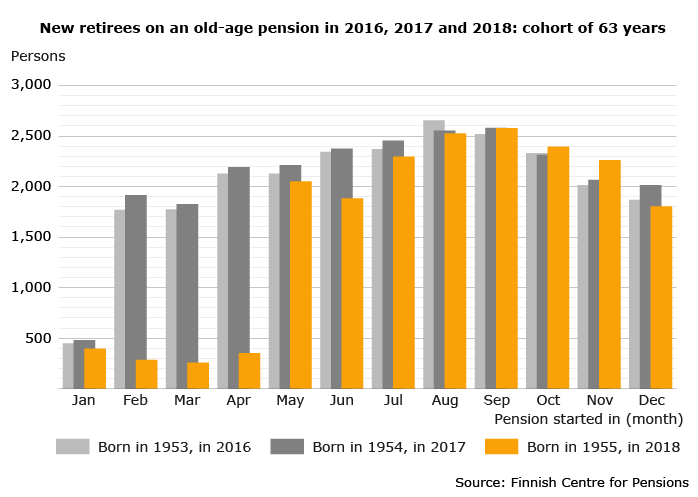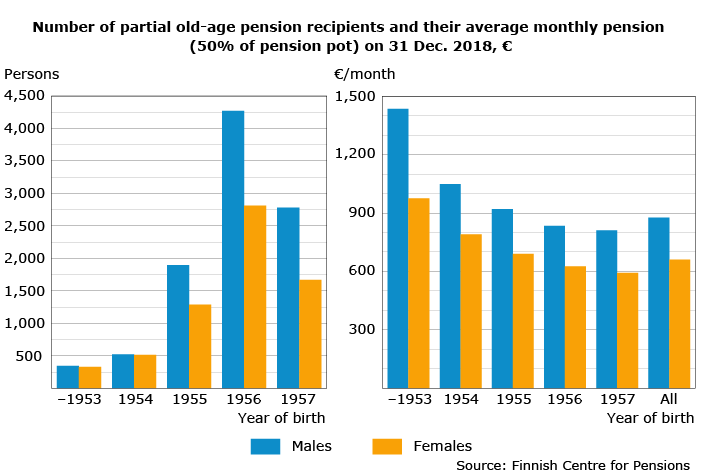New pension benefits 2018
A more recent publication of this set of statistics is available: New pension benefits
New retirement age defers retirement

The 2017 pension reform raised the old-age pension retirement age. The retirement age for those born in 1955 and later rises gradually by three months per age group to 65 years for those born in 1962. The first people to meet the new retirement age retired on an old-age pension in 2018.
Due to the change in retirement age, nobody reached the new retirement age of 63 years and 3 months in January–March 2018. In February–March 2018, only 300 persons retired per month. In 2017, the equivalent figure was 2,000. The total number of new retirees on an old-age pension fell in 2018 with a total of 8,000 persons. This is mainly due to the rising retirement age.
In practice, the change in retirement age means that people have continued working for another three months, until reaching the new retirement age. Those born in 1955 who were working when they turned 63 have continued working at least until the age of 63 years and 3 months.
Retirement on an old-age pension has focused strongly on a few ages: – those who have just turned 62, 63, 65 and 68 years. By far the most popular milepost has been, already for years, the retirement age for the old-age pension, that is 63 years. It was replaced in 2018 by the new retirement age of 63 years and 3 months.
Read more:
Largest group of partial old-age pension recipients consists of the 62-year-olds

At year-end 2018, a total of 18,700 persons received a partial old-age pension. The majority of them (10,800) were men. The largest group of recipients (8,200) were the 62-year-olds (born in 1956).
Nearly 90 per cent of those who have taken out payment of the old-age pension have chosen to take out 50 per cent of their earned pension pot. On average, their monthly partial old-age pension was 790 euros (median: €710). Around 2,300 persons took out 25 per cent of their earned pension pot. They got an average monthly pension of 420 euros (median: €380).
The size distribution of the pension is strongly skewed both in terms of gender and age. Men who took out 50 per cent of their pension pot were paid an average monthly pension of 880 euros while women got only 660 euros. The older the pension recipient, the larger the partial old-age pension was. The average monthly partial old-age pension (at 50%) of men aged between 63 and 68 and women aged between 65 and 68 exceeded 900 euros.
Read more:
Years-of-service pension granted to 27 persons
The years-of-service pension was introduced in the 2017 pension reform. The pension can be granted to individuals who were born in 1955 or after, have done work that requires great mental or physical effort for at least 38 years, and whose ability to work has been reduced.
The first years-of-service pensions began in the spring of 2018.
Situation on 31 December 2018
27 applicants have been granted a years-of-service pension:
- 21 starting pensions in 2018. One of the recipients was female.
- 6 persons have got a positive preliminary decision. The pensions will begin in 2019.
- 5 recipients are still paid the pension.
- 16 years-of-service pensions have ended.
12 applicants have been granted an old-age pension.
6 applicants have been granted a full disability pension.
31 applications have been rejected:
- 16 rejections: The work done has not required enough physical or mental effort.
- 13 rejections: No such work that is required to get the pension, or other legal reason.
- 2 rejections: Other reasons.
Two of the rejected applications have been issued a preliminary decision for a partial disability pension.
The average monthly years-of-service pension in 2018 was 1,978 euros.